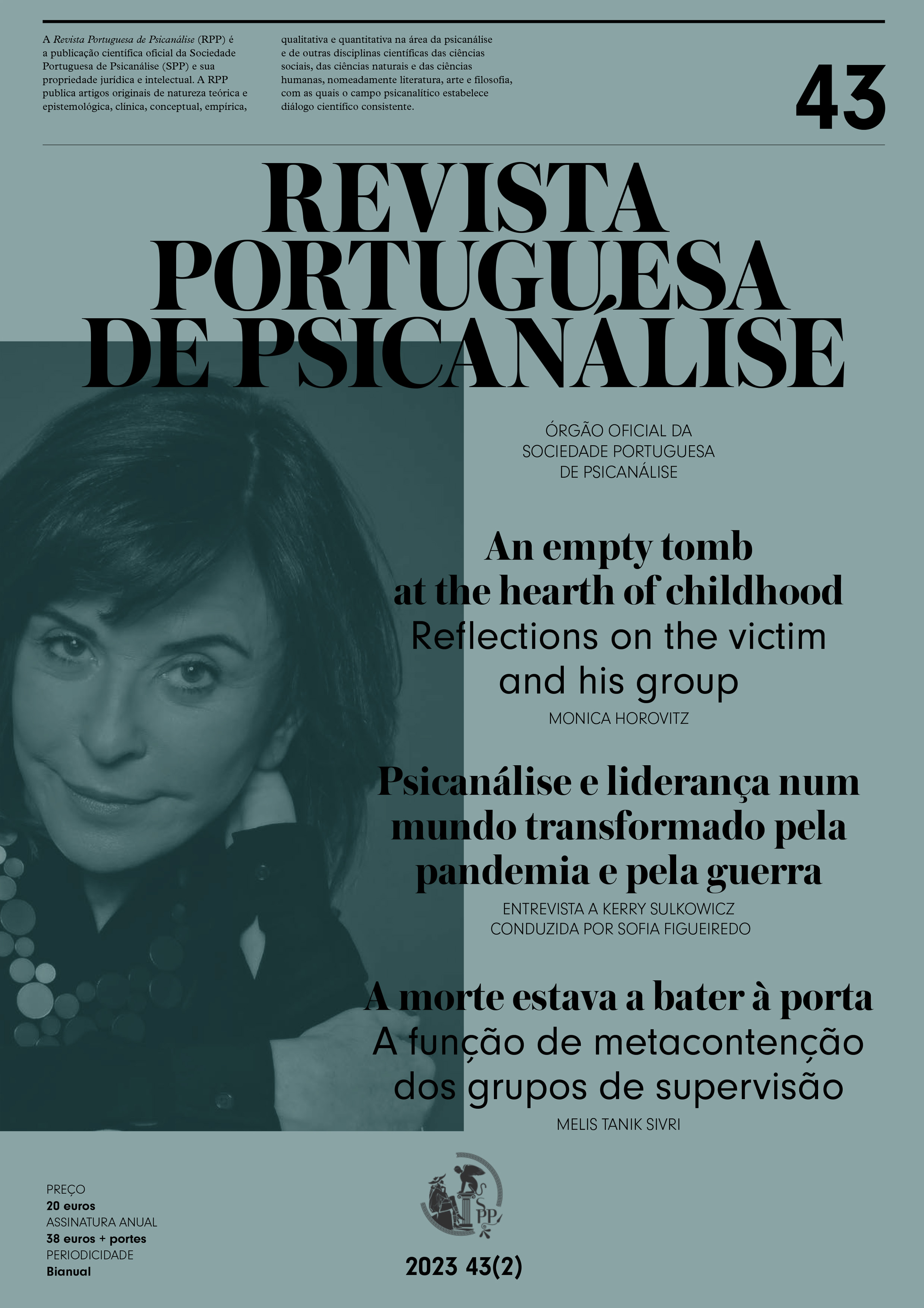Uma imagem vale mais que mil palavras: Tatuagem como expressão da subjetividade

Abstract
An image is worth more than a thousand words: tatoos as an expression of subjectivity
Tatoos have existed in Human history for, at least, 4000 to 2000 years. The
evolution of its use over time is marked by multiple meanings arising from the social
context. The discovery of photography in the early 20th century, as well as the cultural,
social, political and economic changes that occurred in the from 1950s to the new
millennium, radically transformed the vision and philosophy of body use. Tattoos
acquire a new dynamic, as a source of expression, in a modern world where
subjectivation becomes difficult, expressing an intimate relationship without time. The
psychoanalytic exploration of tattooed bodies leads us to the unconscious meaning,
based on the body-Self, the skin-Self, the primary attachment, the challenges of
symbolization, somatization and regression mechanisms. The need to externalize
internal conflicts and assert individuality on the skin, the constant beautification of a
spectacular body, the control of psychotic anxieties, are some of the functions that the
act of tattooing or body modification can fulfill. Some clinical examples from leading
authors are described.
Keywords
tatoo, history, society, psychoanalysis
Author Biography
Jorge Bouça
Psiquiatra, Psicanalista e Membro Associado da Sociedade Portuguesa de Psicanálise, Diretor de Psicodrama Psicanalítico.
References
- Alvarez, L. E., Castro, L. G. & Lasky, C. (2016). Tatuagens: A pele como tela de expressão cultural. Ide, 39(62), 185–192.
- Angelergues, R. (1973). Réflexions critiques sur la notion de schéma corporel. Association de psychologie scientifique de langue française.
- Anzieu, D. (1988). O Eu-Pele. Casa do Psicólogo.
- Bauman, Z. (2006). Amor Líquido. Relógio D’Água. Bick, E. (1968). The experience of the skin in early object-relations. The International Journal of Psychoanalysis, 49(2–3), 484–486.
- Bowlby, J. (1982). Attachment and loss: Retrospect and prospect. American Journal of Orthopsychiatry, 52(4), 664–678. https://doi. org/10.1111/j.1939-0025.1982.tb01456.x
- Catz, H. C. (2011). El trauma en la piel, tatuajes, de las cicatrices mortíferas a las marcas simbolizantes. Revista de Psicoanálisis, 68(2), 823–833.
- Costa, J. F. (2001). A subjetividade exterior. Palestra apresentada sob o título «A Externalização da Subjetividade». Rio Janeiro 2011
- Dejours, C. (1992). Investigaciones psicoanalíticas sobre el cuerpo: supresión y subversión en psicosomática. Siglo XXI.
- Desmurget, M. (2021). A fábrica de cretinos digitais – Os perigos dos ecrãs para os nosso filhos. Contraponto.
- Ferenczi, S. (1915). The ontogenesis of symbols. The Psychoanalytic Review 1913-1957, 2, 106–111.
- Freud, S. (2006).Totem e tabu. Em J. Strachey (Ed.), Edição Standard Brasileira das Obras Psicológicas Completas de Sigmund Freud, vol. 13. Imago. (Original publicado em 1913.)
- Freud, S. (2006). O ego e o id. Em J. Strachey (Ed.), Edição Standard Brasileira das Obras Psicológicas Completas de Sigmund Freud, vol. 19. Imago. (Original publicado em 1923.)
- Grumet, G. W. (1983). Psychodynamic implications of tattoos. American Journal of Orthopsychiatry, 53(3), 482–492.
- Jones, E. (1918). The theory of symbolism. British Journal of Psychology, 9(2), 181–229.
- Karacaoglan U. (2012). Tattoo and taboo: On the meaning of tattoos in the analytic process. The International Journal of Psychoanalysis, 93(1), 5–28.
- Kernberg, O. F. (1989). The temptations of conventionality. The International Review of Psychoanalysis, 16(2), 191–205.
- Kulish, N. (2011). Under the skin: A psychoanalytical study of body modifications by Alexandra Lemma (Routledge). The International Journal of Psychoanalysis, 92(4), 1070–1073.
- Lacan, J. (1998). Escritos. Jorge Zahar. (Original publicado em 1936.)
- Lemma, A. (2010). Under the skin: A psychoanalytic study of body modification. Routledge.
- Lemma, A. (2020). The aesthetic link: The patient’s use of the analyst’s body and the body of the consulting room. Psychoanalytic Perspectives, 17(1), 57–73.
- Lipovetsky, G. (1989). A era do vazio. Relógio D’Água.
- Macedo, S., Paravidini, J., & Próchno, C. (2014). Corpo e marca:Tatuagem como forma de subjetivação. Revista Subjetividades, 14(1), 152–161.
- Maroun, K., & Vieira, V. (2008). Corpo: uma mercadoria na pós-modernidade. Psicologia em Revista, 14(2), 171–186.
- Meltzer, D. (2013). Sur l’objet et le conflit esthétique. Journal de la psychanalyse de l’enfant, 3, 29–39. https://doi.org/10.3917/jpe.005.0029
- Ortega, F. (2006). O corpo transparente: visualização médica e cultura popular no século XX. História, Ciências, Saúde, 13, 89–107.
- Ortega, F. (2008). O corpo incerto. Garamond. Peck, J., & Tickell, A. (2002). Neoliberalizing space. Antipode, 34(3), 380–404.
- Rank, O., Sachs, H., & Payne, C. R. (1964). The significance of psychoanalysis for the humanities. American Imago, 21(1/2), 6–133.
- Rascovsky, A. (1957). Sobre la génesis y evolución de las tendencias escoptofílicas a partir de la percepción interna. Revista de psicoanálisis, 14(3): 255–275.
- Rocha Peixoto, A. (1990). Etnografia portuguesa: Obra etnográfica completa. Etnográfica Press.
- Reisfeld, S. (1999). El cuerpo tatuado: una mirada sobre los adolescentes con tatuajes múltiples. Revista de Psicoanálisis, 56(2), 299–308.
- Rodriguez, L. & Carreteiro, T. (2014). Olhares sobre o corpo na atualidade: tatuagem, visibilidade e experiência tátil. Psicologia & Sociedade, 26(3), 746–755.
- Roussillon, R. (2010). The deconstruction of primary narcissism. The International Journal of Psychoanalysis, 9 (4), 821–837.
- Segal, H. (1957). Notes on symbol formation. The International Journal of Psychoanalysis, 38(6), 391–397.
- Sinclair, A. T. (1908). Tattooing-oriental and gypsy. American Anthropologist, 10(3), 361–386.
- Werbart, A. (2019). “The skin is the cradle of the soul”: Didier Anzieu on the skin-ego, boundaries, and boundlessness. Journal of the American Psychoanalytic Association, 67(1), 37–58.
- Hambly (2009). The history of tattoing: Dover publication. Mineola.
- Winnicott, D.W. (1975). O brincar e a realidade. Imago.